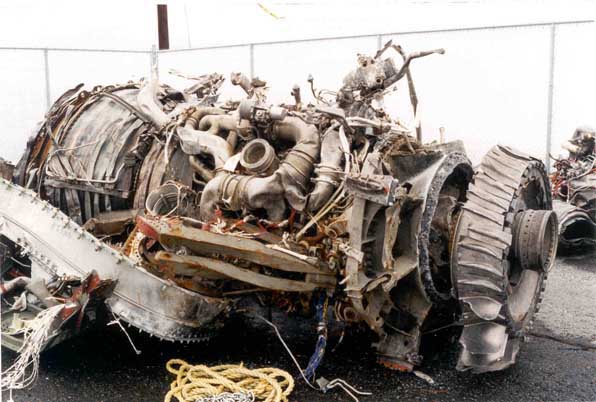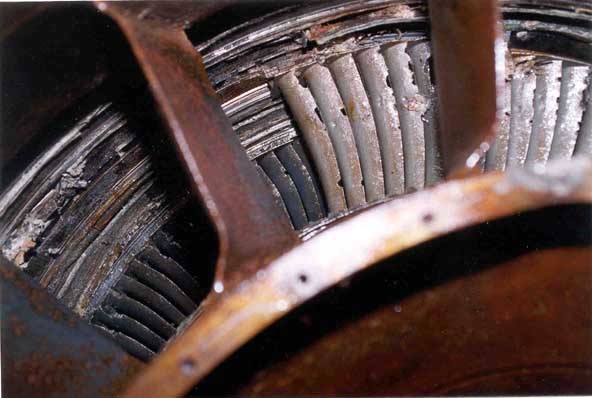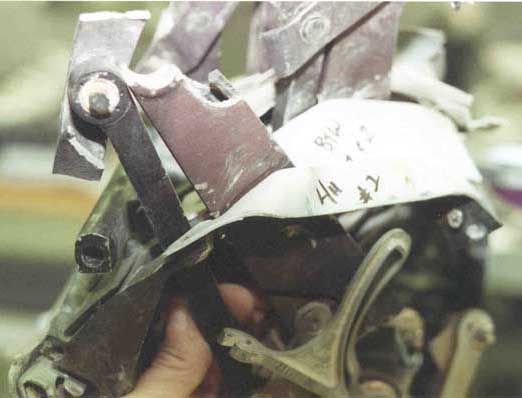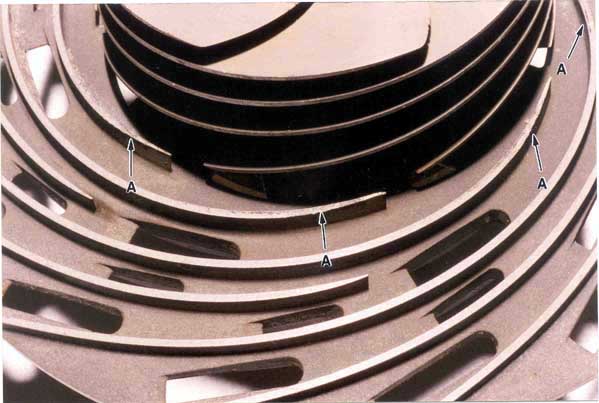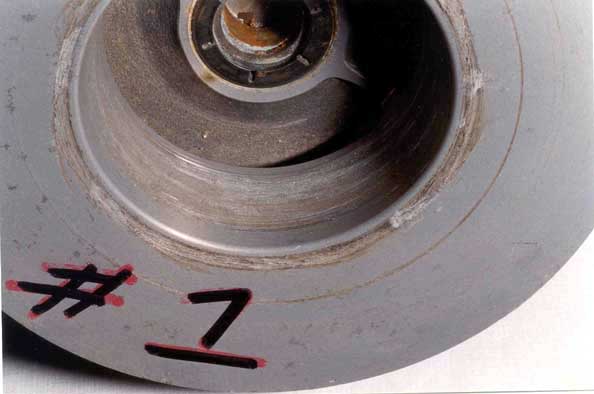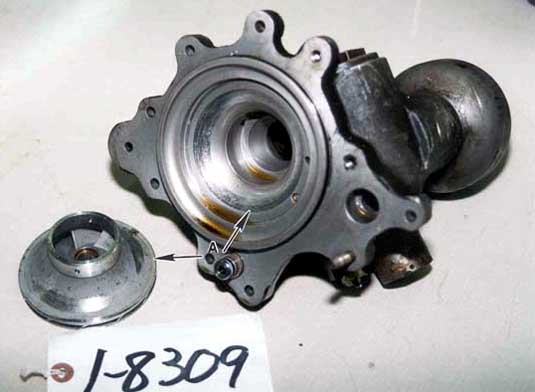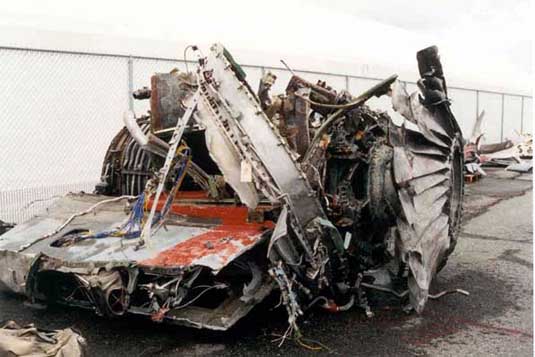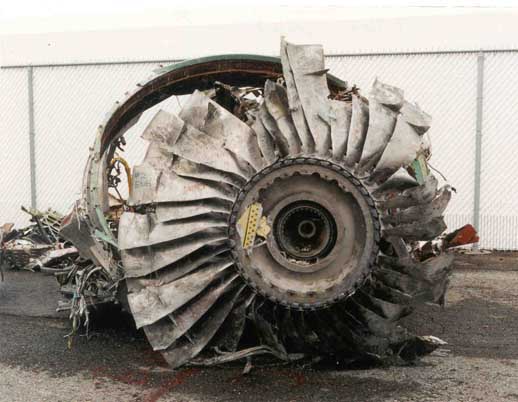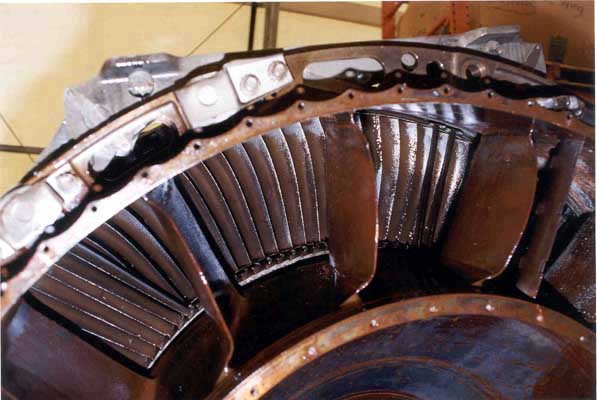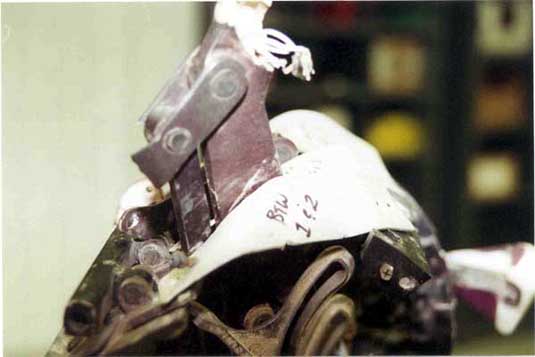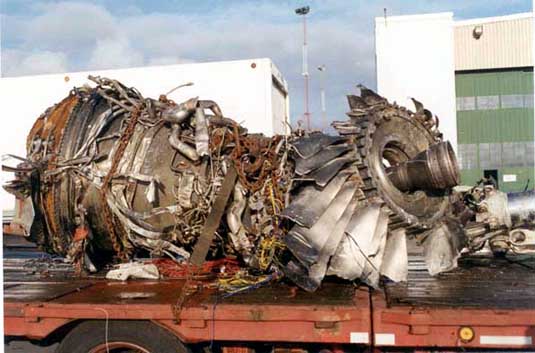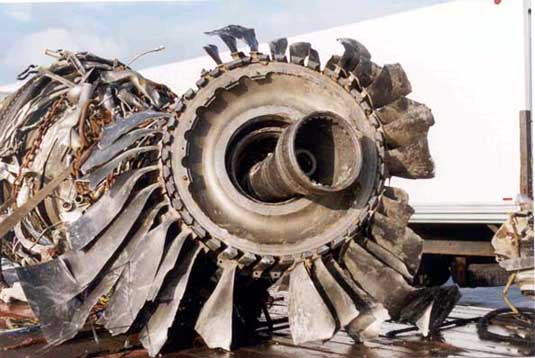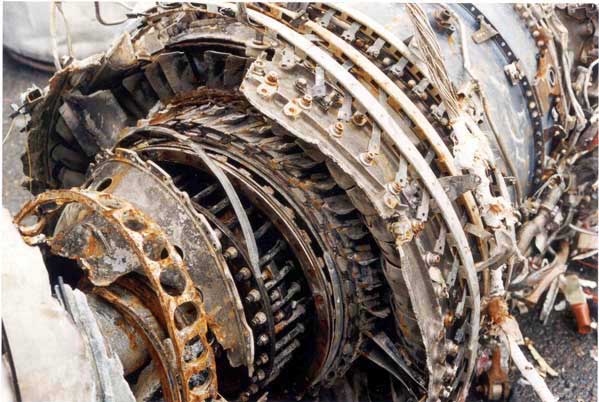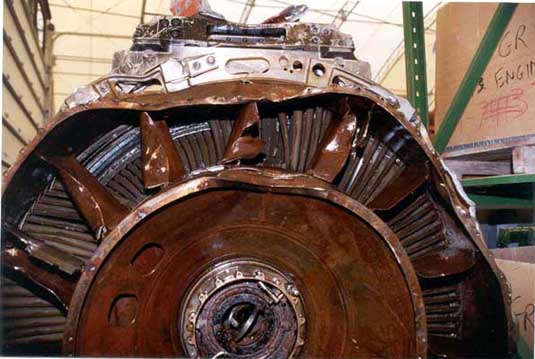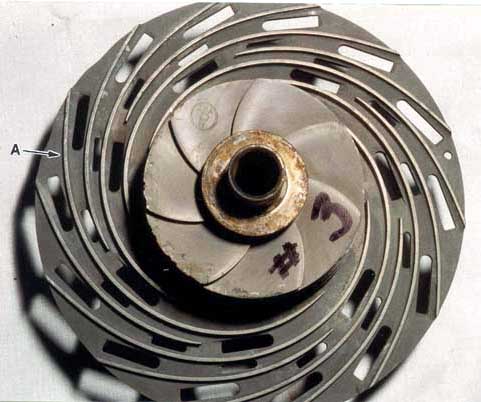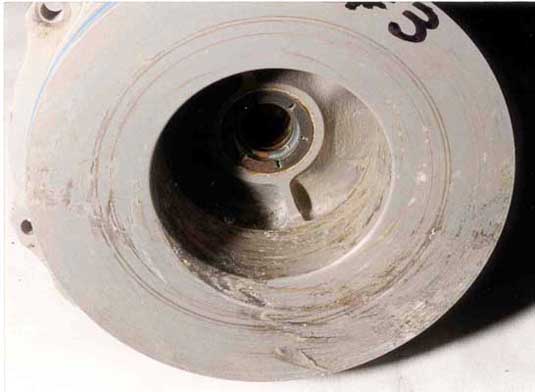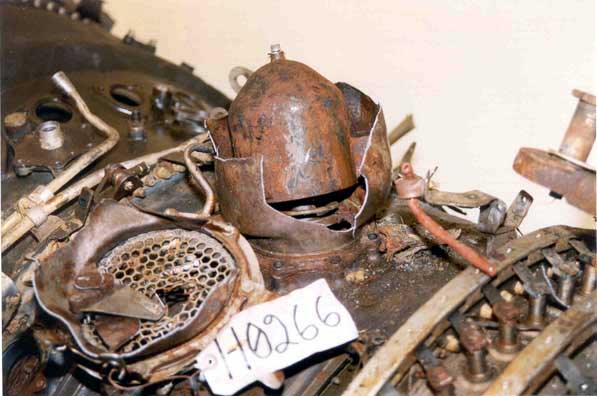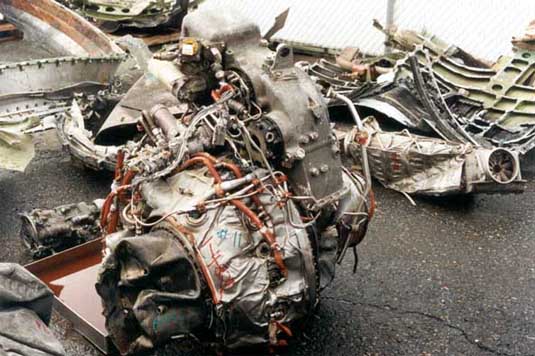Associated links (A98H0003)
Powerplants
Powerplants
Description
The MD-11 aircraft is equipped with three Pratt & Whitney model 4462 engines, one on each wing and one in the vertical stabilizer.Footnote 1 The model 4462 engine is a two-spool axial flow turbofan engine of high compression and bypass ratio with a maximum thrust of 62 000 lb. It has 16 compressor stages, an annular combustion chamber and six turbine stages. The low-pressure section is composed of a 5-stage LPC driven by a 4-stage LPT mechanically isolated from the high-pressure system. The high-pressure system has an 11-stage HPC driven by a 2-stage HPT.
The engine case consists of the fan case (which contains the fan and low-pressure compressor), the intermediate case, the high-pressure compressor case, the diffuser and combustion case, the high-pressure turbine case, the low-pressure turbine case, and the turbine exhaust case. These cases comprise the main support structure for the engine, with the internal parts and components being supported by struts and bearings.
The LPC supplies two air flows. The first stage of the LPC, the "N1 fan," is much larger in diameter than the other 15 compressor stages and provides the secondary (outer) airflow that is ducted outside the engine to give approximately 80% of the engine's propulsive force. The primary (inner) airflow is directed through the engine gaspath, compressed, and ignited, resulting in expanding gases that drive the fan and compressors and produce the remaining 20% of the propulsive force.
The engine installation uses a two-point, fail-safe mount linkage system to attach the engines to the wing pylons and vertical fin base structure. These mounts support the engines and transmit thrust and torque loads from the engines to the aircraft structure.
The mount system for engines 1 and 3 includes the following components:
- Forward mount, located on the rear face of the intermediate case flange at the 12 o'clock position
- Aft mount, located on the turbine exhaust case flange between the 11 and 1 o'clock positions
The mount system for Engine 2 includes the following components:
- Forward mount, located on the rear face of the intermediate case flange at the 12 o'clock position
- Aft mount, located on the turbine exhaust case flange between the 11 and 1 o'clock positions
- Side mount, attached to the rear spar bulkhead and the engine bellmouth
Hydro-mechanical unit
The HMU is a component of the fuel and control system. It is composed of the fuel/oil cooler and bypass valve, the fuel pump and fuel filter, and the fuel metering unit. The fuel and control system performs thrust management and fuel scheduling/metering for all engine operating conditions. It also provides automatic fuel heating and oil cooling, selected component and systems control, and required interfaces with aircraft systems. The fuel flows from the aircraft fuel tanks to the fuel pump boost stage inlet. From the boost pump the fuel flows to the fuel/oil cooler and is then returned to the pump where it is filtered and sent to the main stage. The main stage discharge fuel flows to the FMU, which provides metered fuel through the fuel flow transmitter to the distribution valve and onward through the manifolds to the injectors in the combustion chamber. Servo interface fuel flows are also provided by the FMUs. The FADEC receives aircraft and engine information to schedule fuel flow via an electronic interface with the FMU.
Full-authority digital electronic control
The PW4462 electronic engine control system is a dual-channel FADEC that interfaces with aircraft and engine control components and sensors. The FADEC provides basic engine control functions, condition monitoring for maintenance, and on-board diagnostics and fault detection/storage in NVM that is also used for maintenance purposes.
The FADEC's two electronic channels (A and B) each incorporate a processor, power supply, program memory, selected input sensors, and output drive circuitry. Each channel is independently capable of controlling the operation of the engine. Each channel of the FADEC is electrically powered by a dual-output PMA installed on the respective engine's accessory gear box. The PMA also provides the rotational speed of the HPC or N2 speed, to the FADEC. The FADEC can also be powered by aircraft-supplied 28 V DC. In the accident aircraft, the 28 V DC aircraft power was supplied via an optional SCU with a backup power option. The 115 V AC aircraft power was used to power the engines' inlet Pt2/Tt2 probe heaters.
During normal operations, the FADEC uses all the above-mentioned aircraft-supplied inputs, but is not dependent on this information to ensure safe engine operation. The FADEC contains logic to detect problems with the aircraft-supplied inputs and, if necessary, continues operation based solely on engine-supplied information and electrical power.
There are three digital data buses from the aircraft to each of the two FADEC channels. Two of the buses supply data from the ADCs and the other supplies data from the FCC. FCC-1 provides data to Channel A and FCC-2 provides data to Channel B. The FCCs provide EPR trim, engine service bleed extractions, aircraft on-ground indications, flaps/slats retracted information, and ARINC 429 data from ADC-1 and ADC-2. The ADCs provide pressure altitude, Pt2, and Tt2 to channels A and B.
The FADEC also receives inputs from the engine throttle resolvers located below the central pedestal on the throttle levers. There is a dual-throttle resolver per thrust lever. The dual resolver contains two resolvers in one package driven by a single, common shaft. One resolver provides TRA input to Channel A and the second to Channel B. The FADEC provides electrical excitation for the resolvers.
The FADEC ARINC input processing operates in two modes: the primary sampling mode and the secondary sampling mode. In the primary sampling mode, all of the aircraft data are received from the FCCs. This allows the FADEC to receive the EPR trim signal at the necessary high-update rate. If one FCC bus fails, the FADEC will remain in the primary sampling mode, receiving FCC input by cross-talk from the other FADEC channel. If the FCC inputs are no longer available, the FADEC will switch to the secondary sampling mode. The control will switch to the secondary mode if there is a loss of EPR trim input for 10 seconds, if there are 7 minor outages of 250 ms each, if the total pressure cannot be confirmed when the probe heat is indicated as being off, or if the altitude cannot be confirmed when the left and right ADC agree within a set tolerance.
In the secondary sampling mode, the FADEC sequentially monitors ADC-1, the FCC, ADC-2, and the FADEC transmitter wrap around.Footnote 2 The FADEC waits until all of the data are received from each bus or until the maximum sampling time (250 ms and 550 ms for the FCC and ADC buses, respectively) has elapsed before proceeding to the next bus, which might take up to 1.4 seconds. Because of the length of time required to process the data in the secondary sampling mode, the FCC EPR trim signal is set to zero once the FADEC switches to the secondary sampling mode. The FCC EPR trim signal, therefore, has no effect on the calculation of the EPR command. Other valid inputs from the FCC will be used in the secondary sampling mode.
The thrust management system for the PW4462 is provided in the dual-channel FADEC. The FADEC commands the FMU to set the engine fuel flow as required to establish direct control of the EPR, the prime thrust setting parameter. In the EPR mode, the commanded EPR is calculated in the FADEC as a function of the TRA, altitude, Pt2, M, and Tt2; the flight crew can select the service bleed and anti-ice EPR resets.
When the FADEC detects failures that prevent it from controlling the thrust in the EPR mode, it will automatically switch to an alternate mode of operation. Depending on the cause of the alternate mode selection, the FADEC will switch into one of two alternate modes: the soft reversionary mode or the hard reversionary mode. This switch to the reversionary mode will cause the autothrottle system to disconnect, if it was engaged.
When the FADEC detects failures affecting the rating or the EPR calculations, it switches to the soft reversionary mode to accommodate the failure. This results in a switch from EPR control to N1 control, with a down-trim to the TRA-versus-N1 schedule used to schedule thrust in the alternate mode. The down-trim is used to prevent a change in thrust when switching from the EPR mode to the alternate mode. This down-trim will remain in effect until the flight crew removes it using the FADEC MODE switch. The engine may be thrust-limited (with the down-trim in effect) if the ambient conditions have changed since the FADEC switched to the soft reversionary mode. The crew is not required to take any immediate action when this switch occurs, as the down-trim ensures that the engine will not increase or decrease thrust during the transition from EPR to N1 mode. The alternate mode schedules N1 as a function of thrust lever position; therefore, the crew is still able to control thrust through the throttles.
The hard reversionary mode may be initiated at any time by the flight crew by selecting the appropriate FADEC MODE SELECT switch located on the FADEC MODE panel on the overhead panel. This mode may also be selected by pushing the throttle beyond the normal forward stop position. This hard reversionary mode is the same as the soft reversionary mode except that no down-trim is applied to the TRA-versus-N1 schedule. As the soft and hard reversionary modes are non-rated modes, there is no rating protection available. In the hard reversionary mode, the N1 redline is commanded at maximum throttle. The N1 and N2 redline is always protected and is not affected by the inability to calculate ratings.
If the FADEC switches to the soft reversionary mode, the amber FADEC MODE switch, SELECT and ALTN lights will illuminate and an amber SELECT FADEC ALTN alert will be displayed on the EAD DU. DU 3 normally displays the EAD information. The flight crew can select the hard reversionary mode by pushing the illuminated SELECT ALTN switch. According to the procedures, the throttles must be retarded prior to selecting the hard reversionary mode.
If reversion to the N1 mode occurs, it is possible to attempt to reselect the EPR mode by first reducing the thrust on the affected engine (to 70% N1 or less) and then selecting the FADEC MODE switch twice. With the first selection, the alternate control mode is manually selected, the SELECT light is extinguished, and the ALTN light stays illuminated. A second selection of the same switch may re-select the primary control mode. If the SELECT light does not illuminate and the ALTN light extinguishes, the system has reverted to the EPR mode. If the primary mode is not successfully recovered, it is recommended that all engines be placed in the alternate control mode to avoid throttle stagger and differences in throttle response.
When the FUEL switch is placed in the cutoff position, the FADEC senses a switch closure (one per FADEC channel) and reinitializes to insure proper operation when the engine is restarted. When the switch closes, the volatile fault memory (all latched faults) is cleared, but the NVM is not. Reinitialization lasts approximately 1.2 seconds and performs the following functions: reset of the overspeed latch, reset of latched faults, channel synchronization, and a timer check. As the FADEC receives its primary power from the PMA for critical control functions, a loss of aircraft power will not lead to an external reset.
Each FADEC channel contains 192 cells of NVM that record fault information to improve engine maintenance scheduling and troubleshooting. The fault data are stored sequentially, with Fault 193 overwriting Cell 1. Each fault records five, 16-bit data words per cell that contain the fault code number and the following parametric data: FADEC elapsed operating time, N2 speed, aircraft M, Pt2, FADEC cold junction temperature, and FADEC flight or ground leg number. The fault data are stored when the faults are written into NVM and are recorded only once per flight leg.
The time at which the faults are latched to memory is not synchronized with aircraft time. As the FADEC records the engine run time in 20-minute increments, it is difficult to correlate the time a fault was written to memory with UTC. The data values written to NVM are based on engine measurements and FADEC calculations at the time the fault was written to memory, rather than when the fault occurred. The faults are not necessarily written to the NVM in the order of occurrence. Each fault has a unique pre-determined time delay between the time the fault occurred and the time it is latched. This delay is based on the nature of the fault and its relationship to other faults that may have occurred. Faults are stored in a three-word buffer that is cleared once per second. The buffer is emptied in reverse; that is, the first fault received is the last fault written to the buffer when faults are latched within the same second. There are also artificial default values that are output with certain types of faults.
Bleed valves
The 2.5 bleed air subsystem increases compressor stability during starting, transient, and reverse thrust operation. The 2.5 bleed valve is connected to an actuator through a bellcrank and, when open, releases fourth-stage LPC air into the fan airstream. It is controlled by the FADEC as a function of TRA, N1, N2, Tt2, M, and altitude. During an engine start, the valve is commanded fully open and will begin to close at approximately 70% N2. If a surge is detected on an engine, the valve is commanded fully open. This valve is also fully open during reverse thrust operations on the wing engines but only half open on the tail engine.
The 2.9 bleed valves, located at the ninth-stage HPC, improves compressor stability during starting and transient operation. The FADEC controls the left 2.9 stability bleed valve as a function of corrected N2, altitude, and time and controls the right 2.9 start bleed valve as a function of corrected N2. During an engine start, both valves are open. At approximately 2% N2c2 below idle speed, both valves close. If the FADEC detects a surge at any time, the left valve opens. The left valve also opens for up to 180 seconds if the engine is decelerated below approximately 81% N2 and the altitude is between approximately 16 000 and 20 000 feet; it closes upon acceleration. The valves are spring-loaded open and commanded closed by the FADEC.
Operating limitations
The following operating limits apply to the PW4462 engine:
- 100% N1 = 3 600 rpm
- redline N1 = 111.4% or 4 012 rpm
- 100% N2 = 9 900 rpm
- redline N2 = 105.5% or 10 450 rpm
- maximum thrust = 62 000 lb
Stator vane actuators
The VSV control subsystem provides maximum compressor performance by moving the HPC inlet guide vanes and fifth-, sixth-, and seventh-stage vanes to their programmed positions in response to commands from the FADEC. The VSV control subsystem also improves engine starting properties. During an engine start, the VSVs may be open until approximately 15% N2, at which time they would close. At speeds above approximately 40% N2, the VSVs modulate to open with increasing N1 and N2 and are fully open at take-off and climb power. The vanes modulate with N1, N2, and Tt2 changes.
Engine-driven hydraulic pumps
The main hydraulic power system has three divided systems, each identified by the engine that supplies it with power. The three hydraulic systems are pressurized to 3 000 psi by engine-driven variable-displacement, piston-type pumps. There are two pumps on each engine–one on the left front and one on the right rear of the accessory drive gear box. Although each system has two engine-driven pumps, one pump will provide enough continuous, non-pulsating flow for normal system operation. During system operation, the left pump is selected on and the right pump is armed. The armed pump is depressurized and feathered, and hydraulic pressure is maintained at a reduced rate to lubricate and cool the pump until it is selected on, either manually or automatically. Each pump can provide 37.5 gpm (142 L/min) at 3 000 psi.
The operator maintained a record of the PNs, SNs, flying hours, engine cycles, calendar days installed, and total calendar days of the pumps installed on each engine, but did not record the installation position. This is consistent with industry practice for modern aircraft. Although the PNs and SNs are entered in the component inventory, operator-assigned IDNs and ASNs are used to track the components. These numbers are stamped into an adhesive metallized tag applied to the component case. When the hydraulic pumps were recovered the metallized tags were still attached to the pump cases.
The pumps are numbered according to the engine on which they are installed; the A and B identifiers (e.g.,Pump 1A) were assigned for documentation and report-writing purposes only; they do not indicate whether the pump was installed in the left or right position on the engine gearbox.
Thrust reverser system
When selected by the flight crew, the thrust reverser system decelerates the aircraft on the ground by reversing the direction of the engine thrust. This reduces the length of runway needed to safely and efficiently stop during a landing or a rejected take-off. The aircraft thrust reverser system consists of the following major components: 3 HCUs (1 per engine), 6 upper feedback (non-locking) actuators (2 per engine), 12 centre and lower locking actuators (4 per engine), flexible synchronizing shafts, translating sleeves, blocker doors, thrust-reverser cascades, and electrical harnesses. Of these components, 3 HCUs, 10 locking actuators, and 6 non-locking actuators were recovered and examined (along with 2 rod pieces).
Examination
In some respects, the three engines were recovered in similar condition upon recovery. The fan, HPC, diffuser/burner, HPT, and LPT modules remained joined; the LPC modules were not recovered. The remaining case structures showed no evidence of uncontained internal failures. The fan blade containment rings were recovered intact; however, the fan case, fan exit guide vane case, and outer diameter of the intermediate case were recovered in pieces. As these pieces were retrieved from the accident site, they were examined and assessed in relation to their original installed positions. The amount of external components, hardware, and pylons that remained attached to the engines varied. The three engines showed signs of corrosion consistent with salt water immersion. Various fragments and parts of nacelles, LPC, engine build-up components, and other parts from all three engine positions were recovered from the crash site.
Engine positions were verified by comparing engine module SNs with Swissair maintenance records. Engine 2 was readily identified, as it was recovered with part of its distinctive pylon attached.
The throttle quadrant was recovered and was severely damaged. It had been struck on the upper-right, forward corner, as viewed from the rear, and was crushed and distorted to the left. The three throttles were fractured from the throttle pivot shaft, but remained in the quadrant, attached only by the reverser linkages.
FADEC 2 (SN 4000-0991) and FADEC 3 (SN 4000-1620) were recovered, separated from their respective engines. FADEC 3 exhibited heavier impact damage than FADEC 2. Only a few of the circuit boards from FADEC 1 (SN 4000-0672) were recovered. The EEPROM chips, which constitute the FADEC NVM, were not recovered. The FADECs were returned to the manufacturer, United Technologies, Hamilton Sundstrand Division, for fault data extraction. The FADECs were preserved in de-ionized water until they were examined.
Owing to damage to the Channel A EEPROMs from each engine, no useful data could be recovered. The Channel B EEPROMs from both engines were successfully downloaded and fault data were recovered from the accident flight. Review of the fault data showed that FADEC 2 recorded 20 faults and FADEC 3 recorded 10 faults during the last flight leg. There were no faults written to Engine 3 for the previous six flights and none for Engine 2 for the previous 171 flights. The 10 faults recorded on Engine 3 were also among the first 11 faults recorded on Engine 2.
Determination
The detailed examination of the engines revealed no anomalies that would have prevented normal operation. The lack of a penetration violation of the fan containment rings and engine cases indicated there had been no pre-impact liberation of the internal rotating components. There was no indication of metal impingement on the internal components, indicating that there had been no internal failures in any of the engines' gaspaths.
None of the six engine-driven pumps exhibited anomalies that would have prevented normal operation. Based on the rotational scoring, it was determined that the pumps were being driven by their respective gearboxes at the time of impact; however, it could not be determined which pumps were producing pressure and which were armed.
Analysis indicated that at the time of impact, Engine 1 was producing high power, Engine 3 was producing a lower power than Engine 1, and Engine 2 was shut down.
Engine 1
Description
| Manufacturer | Pratt & Whitney, East Hartford, Connecticut, USA |
|---|---|
| Model | PW4462-3CN |
| SN | P723896CN |
| Date of Manufacture | 2 June 1992 |
| Total Time | 27 659 flight hours |
| Total Cycles | 4 566 cycles |
| Installation Date | 30 April 1998 |
| Time Since Test | 1 906 flight hours |
| Cycles Since Test | 276 cycles |
| Total Time Limit | 14 104 cycles |
| Total Time to Go | 9 538 cycles |
Examination
Fan/LPC
The fan containment ring was intact, distorted, and displaced to the rear of the engine. Several sections of the fan blade rub strip were missing. There were no impact marks on the ring's inner diameter that would indicate a strike by a liberated fan blade. The remainder of the fan case and fan exit guide vane case were not recovered.
The fan hub was recovered intact and the fan blade root attachments were in the blade slots. One blade was fractured inboard of the attachment platform and the remaining blades were fractured above the blade attachment platform. Ten blades retained portions of airfoil, ranging from approximately 6 to 12 inches in length. The features of the fracture surfaces were consistent with overload failure, with no visible evidence of fatigue. The fan rotor was displaced rearward off the LPC/LPT coupling splines; the splines exhibited localized blueing, smearing, and metal transfer. The splines on the inner bore of the fan hub also exhibited blueing, smearing, and metal transfer. Both sets of splines were smeared in the direction opposite to rotation.
The LPC module was fractured. Portions of the Bearing 1 inner race and bearing cage remained on the LPT shaft. No pre-impact distress was noted on the inner race. The fan exit guide vane case had broken away. The inner diameter of the intermediate case remained with the engine and the leading edges of the inner diameter struts exhibited evidence of gouging, rotational scoring, and smearing.
High-pressure compressor
The HPC case was fractured at a plane aft of the IGVs. The IGVs were not recovered. The fifth-stage HPC blades were fractured above the root platform and the fracture surfaces were smeared in a direction opposite to rotation. The fifth-stage VSVs and 15 of the sixth-stage VSVs were not recovered. The remaining sixth-stage VSVs were at various angles and exhibited gouging to the leading edges. An arc of about 45 degrees of the seventh-stage VSVs was fractured above the root platform. The eighth-stage VSVs were also captured at various angles and exhibited leading edge damage. The remaining blades did not exhibit any impingement resulting from metal spray that would indicate a failure of a component upstream in the gaspath. The remaining eighth-stage VSVs and blades downstream were not visible. The VSV unison rings and the VSV actuator remained attached to the engine. The remainder of the HPC case was intact, with some buckling noted in the area of the 2.9 bleed valves.
Diffuser/Combustor
The diffuser/combustor case was fractured from the 8 o'clock position to the 2 o'clock position. The fuel injectors were recovered with the engine; 19 of the 24 injectors were removed and their leading edges were examined. No impingement resulting from metal spray was noted. The injectors exhibited impact damage and were contaminated with dirt, debris, and corrosion to the extent that meaningful testing was not possible.
High-pressure turbine/Low-pressure turbine
The HPT and LPT cases were recovered intact but exhibited some buckling. The exhaust plug was crushed inward over the Bearing 4 housing and the exhaust nozzle was crushed from left to right over the exhaust plug. The LPT case cooling tubes remained attached to the engines but exhibited some inward crushing. The fifth- and sixth-stage turbine (third- and fourth-stage LPT) blades were fractured above the root platform and the fifth and sixth turbine vane segments were damaged, dislodged, or both. The trailing edges of the fourth-stage turbine vanes were damaged. The fifth- and sixth-stage turbine outer airseal honeycomb was rubbed out.
The four Pt4.95/Tt4.95 exhaust probes remained in their installed locations and were undamaged. The turbine exhaust case struts were undamaged. The rears of the main Bearing 4 rollers displayed no deformation, but the bearing had been pushed aft, fracturing the retaining flange.
Borescope examination
Several clock locations and stages of the HPC, combustion chamber, and leading edges of the first-stage HPT blades were examined using a borescope. Numerous broken blades and blades with tip smearing were observed, along with post-impact debris. No impingement resulting from metal spray was noted on the components.
Engine 1 mounts
The forward engine mount was still installed on the engine. The bolt that attaches the engine mount to the intermediate case was fractured at the first thread below the radius. The engine mount had fractured where the mount lug enters the mount crossbeam. The mount was submitted to the Material Analysis Division of the TSB for failure analysis. It was determined that the mount lug failed instantaneously in bending overload in an upward direction. In contrast to the Engine 3 mount, this mount failed with less indication of a clockwise torque load.
The aft engine mount was found installed on the engine. The forward attachment flange of the aft engine mount was bent forward and down on the left side. The rear attachment flange was bent aft, giving the appearance that the mount had twisted forward on the left side and aft on the right side.
Engine 1 full-authority digital electronic control
Electronic circuit boards from the Engine 1 FADEC were recovered; however, the EEPROM chips containing the NVM were not recovered. As a result, no recorded FADEC information was retrieved that might have revealed the operational status of Engine 1 at the time of impact. Some of the faults that were recorded on FADEC 2 and FADEC 3 would also likely have been recorded on FADEC 1. The resulting effect on the engine would have been similar.
Engine 1 supplemental control unit
The SCU from Engine 1 was recovered; however, since the NVM chip was not recovered, no information was retrieved.
Engine 1 throttle lever angle
The throttle was found in the throttle quadrant, displaced toward the left side, fractured free of the throttle pivot shaft but attached to the thrust reverser linkage. This displacement caused the throttle to contact the throttle quadrant, resulting in impact marks on the throttle shaft.
These impact marks were aligned and the position of the throttle relative to full throttle position was measured. The measurements were forwarded to the manufacturer of the aircraft, where they were interpreted into TRAs and thrust levels. One calculation assumed that the engine was operating in the primary EPR mode of control while a second calculation assumed the engine was operating in the manually selected hard reversionary N1 mode. The thrust levels in the EPR mode are the lowest possible thrust levels that each engine would produce for the given TRAs.
Calculated thrust levels, using an ambient temperature of 15°C, for Engine 1 operating in the primary EPR mode of engine control, are presented in the table below. According to the engine manufacturer, these calculated thrust values are also considered to be closely representative of the engine operating in the soft reversionary N1 mode of control, assuming the throttle did not move once the engine entered the soft reversionary mode.
| Engine | Mode | TRA | EPR | Thrust |
|---|---|---|---|---|
| 1 | EPR | 77.93 | 1.5778 | 45 960 lbf |
If the aircrew had selected the hard reversionary N1 mode, then the downtrim would have been removed. The thrust level values for Engine 1 operating in the selected N1 mode, presented in the table below, were calculated using an ambient temperature of 15°C:
| Engine | Mode | TRA | N1 | Thrust |
|---|---|---|---|---|
| 1 | N1 | 77.93 | 111.8% | 54 195 lbf |
Engine 1 hydro-mechanical unit
The fuel bypass valve of the Engine 1 HMU was fractured, the pump body exhibited impact damage, and the electrical connections on the FMU were missing. Disassembly and examination revealed the presence of fuel, and a fuel sample was secured. The fuel filter and filter housing were contaminated with sand and dirt. No internal components appeared to have suffered a pre-impact failure. Rotational scoring was observed on the impeller and on the inlet housing from the impeller and inducer.
Engine 1 fuel metering unit
| Manufacturer | United Technologies |
|---|---|
| PN | 801000-3 |
| SN | F31714 |
| Model | JFC131-2 |
| Swissair IDN | 473699 |
| Swissair ASN | 183 |
The accumulated time in hours, cycles, and days on the FMU 1 was as follows:
| Flying hours | Engine cycles | Calendar days | ||
|---|---|---|---|---|
| Installed | Total | |||
| Total Time | 16 542 | 2 896 | 1 402 | 1 536 |
| Time Since Overhaul | 5 049 | N/A | N/A | N/A |
| Time Since Bench Test | 5 049 | N/A | N/A | N/A |
The Engine 1 FMU was disassembled and examined at the component manufacturer's facility. It was sufficiently disassembled to permit measurements of the metering valve spool with respect to the metering valve sleeve. Photographs of the segment gear and resolver pinion gear were taken in an attempt to correlate the as-received fuel flow settings of the unit. From the measurements it was determined that the condition of the metering valve was at, or near, maximum fuel flow–that is, between 26 900 and 28 400 pounds per hour. The position of the segment gears supports the position of the metering valve.
Engine 1 SVA
| Manufacturer | Hamilton Standard |
|---|---|
| PN | 813664-2 |
| SN | F23304 |
| Model | GTA41-1 |
| Swissair IDN | 473767 |
| Swissair ASN | 148 |
The accumulated time on the Engine 1 SVA in hours, cycles, and days was as follows:
| Flying hours | Engine cycles | Calendar days | ||
|---|---|---|---|---|
| Installed | Total | |||
| Total Time | 20 632 | 3 601 | 1 575 | 2 345 |
| Time Since Overhaul | 2 117 | N/A | N/A | N/A |
| Time Since Bench Test | 1 914 | N/A | N/A | N/A |
The back shell of the SVA and the LVDT were removed to measure the "as-received" position of the piston. The distance between the aft housing surface and the centre of the piston surface was 4.089 inches, which indicates that the piston was approximately 0.200 inches from the fully extended (piston-bottomed) position. The piston was extended to approximately 95% of its stroke. This position is consistent with a high level of thrust, at or near take-off power.
Examination of the piston assembly revealed a witness mark, approximately 0.5 inches along the circumference, on the outside diameter of the piston rod. The witness mark was considered to have been made when the piston struck the actuator housing at the time of impact. With the piston positioned so that the mark was at the end of the actuator scraper, the piston was approximately 1.6 inches from the fully extended position (i.e., at approximately 63% of its stroke). This position is indicative of an engine developing a level of thrust between idle and climb power.
Hydraulic pump 1A
The manufacturer's SN or PN were not found on this pump; however, the operator's metallized tag remained attached to the pump housing. By referencing the ASN and IDN to the maintenance records, the following information was obtained.
| Manufacturer | Vickers, Incorporated |
|---|---|
| Model | Unknown |
| PN | 623977 |
| SN | MX-510706 |
| Swissair IDN | 468179 |
| Swissair ASN | 41 |
The accumulated time in service in hours, cycles, and days on Pump 1A was as follows:
| Flying hours | Engine cycles | Calendar days | ||
|---|---|---|---|---|
| Installed | Total | |||
| Total Time | 31 813 | 5 860 | 2 444 | 2 784 |
| Time Since Overhaul | 31 813 | N/A | N/A | N/A |
| Time Since Bench Test | 21 880 | N/A | N/A | N/A |
Visual examination of Pump 1A revealed that the pump mounting flange had fractured and was missing. The remainder of the pump body appeared undamaged and exhibited minor amounts of hydraulic fluid, which appeared amber to clear. Rotational smearing was noted on the pump impeller and valve block assembly. Salt water corrosion was also noted.
Hydraulic pump 1B
| Manufacturer | Vickers, Incorporated |
|---|---|
| Model | PV3-240-10 |
| PN | 623977 |
| SN | MX-510721 |
| Swissair IDN | 468179 |
| Swissair ASN | 43 |
The accumulated time in hours, cycles, and days on Pump 1B was as follows:
| Flying Hours | Engine Cycles | Calendar Days | ||
|---|---|---|---|---|
| Installed | Total | |||
| Total Time | 31 823 | 5 806 | 2 440 | 2 784 |
| Time Since Overhaul | 31 823 | N/A | N/A | N/A |
| Time Since Bench Test | 21 313 | N/A | N/A | N/A |
The pump base, inlet, and outlet of Pump 1B had fractured and was not recovered; the remainder of the pump body appeared undamaged. The drive shaft exhibited impact damage. Residual amounts of amber to clear hydraulic fluid were noted. The impeller had seized on the drive shaft due to salt water corrosion, and was sectioned to continue the examination. No additional anomalies were noted. Faint indications of rotational damage on the pump impeller and valve block assembly were observed.
Determination
Engine 1, which is mounted on the left wing, suffered the most extensive impact damage, with signatures of rotation throughout. The smearing, blueing, and metal transfer of the material of the rotating components on adjacent surfaces are consistent with the engine rotating at a high rpm at the time of impact. The gouging observed on the leading edges of the compressor and turbine blades is also consistent with the engine rotating as the impact debris was introduced into the engine gaspath. These rotational signatures were most evident during the borescope internal examination of the engine, which revealed that the high level of damage was consistent throughout. Based on the lack of metal impingement, it was determined that the rotating components had not failed prior to impact.
The engine operational information recorded by the FDR throughout the accident flight indicated that Engine 1 was operating normally, with no engine anomalies. Just prior to the FDR losing electrical power, the engine was producing power in the flight idle range; however, the damage sustained by the engine is consistent with the engine having been operating at high power at the time of impact. This power level is corroborated by the information gathered from the throttle angle analysis, FMU analysis, stator vane examination and analysis, and the 2.9 bleed valve position. Analysis of the 2.5 bleed valve, in isolation, would indicate low power, but the cumulative evidence of high power is convincing and conclusive. The severity of the rotational damage of the internal rotating components and the analysis of the accumulated evidence collected from the examination of the associated components indicate that Engine 1 was producing a high level of power at the time of impact.
As the NVM component of the Engine 1 FADEC was not recovered, no recorded data were available to determine the engine's mode of operation at the time of impact. However, the failures of the FCCs and ADCs would affect all three FADECs. These failures would cause the Engine 1 FADEC to switch into the secondary sampling mode, but this would have little effect on engine operation.
It was determined that the wiring for the Engine 1 probe heater was not routed through the fire zone and was most likely not affected by the fire. It was also determined that some time after the FDR and CVR had stopped, the flight crew had selected the SMOKE ELEC/AIR selector to the 1/2 OFF position; this would have caused a probe heat fault to be set in FADEC 1. When the probe heat fault was set, FADEC 1 would have reverted from the EPR mode of control to the soft reversionary N1 mode of control and the thrust levels would have been dependent on the throttle position selected.
It is possible that, similar to Engine 2, the TRAs to the Engine 1 were lost as their wiring was routed through areas of high heat. If this had occurred, the FADEC would have entered a fixed thrust mode at, or slightly above, flight idle, as most faults were considered to have been set at approximately 10 000 feet asl, with the aircraft in descent. However, it is likely incorrect to assume that the engine was in the fixed thrust mode at the time of impact, as cumulative evidence indicates that the engine was producing a level of power normally associated with the take-off phase of flight. In fixed thrust, the engines do not follow the throttles, and the thrust setting cannot be changed.
Based on the use of the SMOKE ELEC/AIR selector and the extensive impact damage, it was determined that, at the time of impact, the engine was operating in the reversionary N1 mode at a high level of thrust. It could not be determined whether the flight crew had selected the hard reversionary N1 mode or the engine was operating in the soft reversionary N1 mode.
There was no indication of an engine fire.
Engine 2
Description
| Manufacturer | Pratt & Whitney, East Hartford, Connecticut, USA |
|---|---|
| Model | PW4462-3CN |
| SN | P723856CN |
| Date of Manufacture | 30 September 1991 |
| Total Time | 29 456 flight hours |
| Total Cycles | 5 133 cycles |
| Installation Date | 24 October 1997 |
| Time Since Test | 4 686 flight hours |
| Cycles Since Test | 694 cycles |
| Total Time Limit | 14 786 cycles |
| Total Time to Go | 9 653 cycles |
Examination
Fan/Low-pressure compressor
The fan containment ring was intact but distorted and displaced rearward. Most of the blade rub strip material was intact. The rub strip exhibited axial gouge marks along the circumference. There were no impact marks on the ring's inner diameter that would indicate a strike by a liberated fan blade. The remainder of the fan case, fan exit guide vane case, and outer diameter portion of the intermediate case were not recovered.
An unidentified deposit was observed on the face of the fan blades. Two blades were examined further, at the engine manufacturer's laboratory in East Hartford. The deposits were determined to be environmental in origin, deposited after the crash.
The fan hub was intact. All but one of the fan blade root attachments were found in the blade slots. Sixteen full-length fan blades were, to varying degrees, bent and twisted aft and in the direction of rotation. The remaining blades were fractured at varying lengths, from approximately 10 inches above the root platform to just inboard of the part span shroud. Most of the blades exhibited contact damage from the trailing edge to leading edge, and some of the blades had overlapped (shingled).
The fan rotor was displaced rearward off the LPC/LPT coupling splines. No localized blueing or metal transfer was noted on the coupling splines. A small area of the coupling spline teeth, approximately 3/4 x 4 inches, was flattened.
The LPC module had broken away. Portions of the Bearing 1 inner race remained on the LPT shaft and no pre-impact distresses were noted on the inner race. The inner diameter of the intermediate case remained with the engine and the leading edge of the case inner struts exhibited rotational scoring and smearing damage.
High-pressure compressor
The HPC case was recovered intact, with some engine build-up components still attached. Debris from the engine break-up and the closed position of the IGVs prevented examination of the fifth-stage HPC.
Diffuser/Combustor
The diffuser/combustor was recovered intact. Of the 24 fuel injector nozzles, 23 were removed and their leading edges examined. No impingement resulting from metal spray was noted. Contamination of the injector nozzles with dirt and debris, and corrosion from immersion in salt water prevented meaningful testing.
High-pressure turbine/Low-pressure turbine
The HPT and LPT case was recovered intact. A large per centage of the cooling air manifolds remained attached to the engine. The rear of the LPT was observed from the exhaust. The sixth-stage turbine (fourth-stage LPT) had a section of blades missing equivalent to an arc of approximately 45 degrees (see picture). These blades were fractured just above the root platform. None of the remaining blade material was bent or rolled over. The remainder of the sixth-stage turbine blades, vanes, and the fifth-stage blades remained attached, with no visible damage. No foreign deposits were noted on the airfoils or centrifuged under the blade tip shrouds, and no impingement resulting from metal spray was observed on the components. The No. 4 main bearing rollers appeared normal with the exception of the salt water corrosion.
Borescope examination
Several stages and clock locations of the HPC, combustion chamber, and leading edges of the first-stage HPT blades were observed by borescope. Although no rotational damage or impingement resulting from metal spray was observed at these locations, dirt and debris were present.
Engine 2 mounts
The forward engine mount was installed at the 12 o'clock position on the engine intermediate case and was generally unremarkable.
The aft engine mount was installed on the engine turbine exhaust case. Neither the mount or its installation flanges were visibly bent or distorted. The mount was adjacent to the forward installation flange.
Engine 2 full-authority digital electronic control
The Engine 2 FADEC was recovered from the accident site and transported to the component manufacturer's facilities to recover the information stored in the NVM. The recovered data contained information about the previous 171 flights, as well as the accident flight. No engine faults were recorded, either on previous flights or on the accident flight; however, 20 airframe fault entries were recorded during the accident flight. Data were only available from Channel B.
Analysis of the FDR showed that the FCC-1B failed at 0124:59 (N2 = 8 554 (86.4%) and Alt = 10 325). ADC faults are not written by the FADEC until both FCCs have failed. ADC-1 (airspeed and altitude) stopped recording at 0125:06 (N2 = 8 450 (85.4%) and Alt = 10 375).
The effect of the faults on engine operation are described below. Faults 14 to 20 recorded on FADEC 2 were duplicates of those that occurred early in the flight. Under normal conditions, faults are written to the NVM only once per flight. The repetition of these faults indicates that the FUEL switch for Engine 2 was placed in the cut-off position, shutting down the engine and causing the FADEC to perform an external reset. As the FADEC reinitializes, any faults that are detected are latched and written into the NVM. The N2 values associated with the seven duplicate faults on FADEC 2 and written at the time of shutdown were plotted against time. It was determined that these values were consistent with an engine shutdown resulting from the selection of the cutoff position using the FUEL switch. The time for N2 to decay to a stable windmilling speed was consistent with the proprietary PW4000 series engine shutdown data on file with the manufacturer.
| Fault | Cause, Time Delay, Description, and Effect on Engine Operation |
|---|---|
| 1 - ST350X N2 = 6 912 (69.8%) Pt2 = 12.25 Pamb = 9.94 Alt = 10 469> M = 0.55 |
This fault indicates that the opposite channel wrote an octal 350 maintenance message. As this was recorded on Channel B, Channel A experienced the fault. From the analysis of FDR parameters, it was determined that FCC-1 was lost at 0124:59. This fault would have generated the ST350X message and would have been recorded on all three FADECs. This fault would have been written to the NVM 10 seconds after the occurrence; FCC-2 was still functional at this time. The FADECs would have stayed in the primary sampling mode as they would have been receiving valid data from FCC-2. FCC-2 was still functional at the time the FDR stopped recording at 0125:41. The autothrottle system would still have been engaged, and would have been controlling the thrust requirements for all three engines when the recorders were lost. |
| 2 - FIXME N2 = 6 016 (60.8%) Pt2 = 12.5 Pamb = 10.31 Alt = 9518 M = 0.53 |
This fault is set upon detection of an ADC or FCC bus fault. It was determined that this fault was generated by the next fault recorded, FCCF. The FIXME fault is written to memory one second before the FCCF fault. This fault had no effect on engine operation. |
| 3 - FCCF N2 - 6016 (60.8%) Pt2 = 12.5 Pamb = 10.20 Alt = 9 787 M = 0.55 |
This fault is set if there is no valid EPR trim word for 10 seconds, if there are 7 minor outages of FCC data lasting 250 ms each, or if the engine Pt2 or Pamb cannot be validated by the ADC data on the first pass in the secondary mode. This FCCF fault is written to the NVM 10 seconds after the occurrence and causes the FIXME fault to be written. As FCC-1 had already failed, this fault would have forced the FADEC into a secondary sampling mode, where it would have sampled the ADC inputs directly. This fault had no effect on engine operation. The loss of FCC-2 would also have been written to FADECs 1 and 3. |
| 4 - RADCF N2 = 6 656 (67.2%) Pt2 = 12.25 Pamb = 10.16 Alt = 9 874 M = 0.52 |
This fault is set by an ADC-2 bus fault in the event of a major outage lasting more than 10 seconds or in the event of 7 minor outages during which no valid data are received in the ADC sampling period. This fault is not set below an M of 0.21. Significantly, the ADC faults are not flagged in the primary sampling mode, where only the FCC-1 and FCC-2 data are used. This fault confirms the loss of both FCCs at this time. This fault would have been written five seconds after the loss of FCC-2. This fault had no further effect on the operation of Engine 2. This fault would also have been written to FADECs 1 and 3. |
| 5 - EXDISF N2 = 6 912 (69.8%) Pt2 = 12.25 Pamb = 10.16 Alt = 9874 M = 0.52 |
This fault is set if the local and cross-talk values for any of the discretes listed below disagree. Fail-safe values are also listed and are used for those discretes that disagree: FADEC power source: SCU; probe heat: off; alternate mode: N1 mode; reset: fuel on; engine location: wing engine. The maintenance and fire discretes are also included in this logic. If the cross-talk is not rational, the cross-talk is not performed and the local input is assumed correct. This fault is set one second after a disagreement between the local and remote values of one of the external discrete parameters. The cause of this fault could not be determined. This fault may effect engine operation, depending on the discrete that has failed. |
| 6 - LADCF N2 = 7 424 (75.0%) Pt2 = 12.0 Pamb = 10.116 Alt = 9 985 M = 0.50 |
This fault is set as a result of the same conditions as the RADCF. It is set five seconds after the loss of FCC-2. This fault would also have been written to FADECs 1 and 3. This fault had no effect on engine operation. |
| 7 - PHEATF N2 = 7 296 (73.7%) Pt2 = 12.0 Pamb = 10.374 Alt = 9 379 M = 0.46 |
This fault is set if the Pt2/Tt2 Engine 2 probe heater fails or loses power. However, this fault is unique to FADEC 2, as the source of power for the probe heater for Engine 2 is from the 115 V AC Bus 2. This fault causes the FADEC to revert from the primary EPR mode to the soft reversionary N1 mode and disconnect the autothrottle system. The FADEC then calculates a down-trimmed N1 schedule. This down-trim can result in the engines being thrust-limited if there is a significant change in ambient conditions. However, in terms of engine operation, the ambient conditions on the night of the accident at 10 000 feet asl were determined to have been similar to those at sea level. As a result, the calculated down-trim would have been insignificant. At reversion, the FADEC 2 MODE push-button switch located in the overhead panel illuminates the SELECT and ALTN lights, and the EAD displays an amber alert message: "SELECT FADEC ALTN." The down-trim would have been removed if the FADEC mode of control had been manually selected to the hard reversionary N1 mode using this switch. The hard reversionary N1 mode would also have been selected if any of the throttles were pushed past the normal forward stop position, actuating the overboost bar. If the PHEATF fault resulted from an interruption in Generator 2 (e.g., if the SMOKE ELEC/AIR selector had been selected to the 2/3 position), the SELECT and ALTN lights would not have illuminated, as they are powered from the 28 V DC Bus 2. |
| 8 - P2BAD N2 = 7 296 (73.7%) Pt2 = 12.25 Pamb = 11.928 Alt = 5 711 M = 0.20 |
This fault is set to indicate a possible Pt2 probe icing condition or the failure of the Pt2 line. This fault requires that the PHEATF fault be set. This fault indicates a problem validating the engine Pt2 measurement, either as a result of a difference between the engine probe and the ADC supplied total pressure or a total fault from the ADC. This fault also results in a default M of 0.20 being set in the NVM for this fault and all subsequent faults. This default M indicates that the altitude calculated from the NVM fault data Pt2 and M are not accurate. The P2BAD fault is set 10 seconds after the fault occurrence. This fault had no effect on engine operation. The Pt2 recorded in the NVM was received from the engine probe and was not validated by ADC data. Given that icing conditions were not present and that the engine did not fail, the Pt2 data are likely valid. The altitude shown in the fault print-out is biased by the fixed M. |
| 9 - TRAXCF N2 = 7 168 (72.4%) Pt2 = 12.5 Pamb = 12.172 Alt = 5 137 M = 0.20 |
This cross-check fault is set if the local and remote throttle resolver angle input signals differ by more than 1.5° for more than one second. This fault is written one second after the fault occurs. This fault is unique to FADEC 2 and, coupled with the later TRAL fault and the DONTGO fault, indicates the loss of both TRA signal inputs to FADEC 2. The loss of the TRA input signals to the FADEC causes Engine 2 to go into a fixed thrust at a setting determined by the last validated TRA value. Without TRA input, the engine does not respond to changes in throttle lever position. |
| 10 - LOST28 N2 = 7 168 (72.4%) Pt2 = 15.25 Pamb = 13.612 Alt = 2 102 M = 0.41 |
This fault is set for the same reasons as above. This fault would only be written to FADEC 2, since the source of FADEC Channel B performance solenoid power is the 28 V DC Bus 2. Other than the loss of performance solenoid power, which would slightly affect the engine's thrust specific fuel consumption, this fault would not have had a noticeable effect on Engine 2. This fault is set 10 seconds after the loss of the power input. |
| 11 - CASHUN N2 = 7 168 (72.4%) Pt2 = 15.00 Pamb = 14.606 Alt = 177 M = 0.20 |
This fault is set 10 seconds after the LOST28 fault is written (owing to this not being the control channel). It was determined that the FADEC reinitialized with Channel A in control, which resulted in the generation of this fault 10 seconds after LOST28 was set. |
| 12 - TRAL N2 = 7 168 (72.4%) Pt2 = 14.75 Pamb = 14.363 Alt = 636 M = 0.20 |
This fault is set if the TRA position exceeds the limits of 3.7° to 87.8° resolver angle for more than one second, if the rate exceeds 600° per second, or if the local resolver analog-to-digital FADEC interface is lost. This fault is written one second after the fault occurrence. |
| 13 - DONTGO N2 = 7 040 (71.1%) Pt2 = 15.00 Pamb = 14.606 Alt = 177 M = 0.20 |
This fault indicates that an aircraft with this fault could not be dispatched for flight in this condition. This fault was set by the loss of both TRA signal inputs to FADEC 2, which would have generated a Level 1 ENG 2 FADEC MAINT alert. In flight, this alert is not displayed on the EAD. The EAD displays a flashing "ENG" symbol; the full text of the alert is displayed on the secondary engine page. Engine 2 was shut down at approximately 1780 ±470 feet asl with an Engine N2 of approximately 7 040 rpm, or 71.1%. The altitude is based on Pt2 values with an aircraft airspeed of approximately 227 kt true airspeed. |
| 14 - FIXME N2 = 5 888 (59.5%) Pt2 = 15.00 Pamb = 13.771 Alt = 1 782 M = 0.35 |
This fault is set as a result of the following TRAL fault and is set 1.2 seconds after reinitialization, which takes 1.2 seconds. The reinitialization of the FADEC indicates that it was being powered by the associated PMA at the time of the engine shutdown, as the FADEC requires power to rewrite the faults into memory. If the FADEC experiences a total loss of electrical power (PMA and SCU failure), the engine FMU reverts to a fail-safe position of minimum fuel flow (approximately 450 lb per hour). |
| 15 - TRAL N2 = 5 376 (54.3%) Pt2 = 15.00 Pamb = 13.823 Alt = 1 681 M = 0.33 |
This fault is set for the same reasons as above and is set one second after reinitialization. This fault, along with the DONTGO fault written two faults later, indicates a dual TRA input fault to the FADEC, since it is rewritten after the reset. |
| 16 - PHEATF N2 = 4 608 (46.5%) Pt2 = 15.00 Pamb = 13.823 Alt = 1 681 M = 0.34 |
This fault indicates that the Pt2/Tt2 probe heat is still off; it is set five seconds after reinitialization |
| 17 - DONTGO N2 = 4 352 (43.9%) Pt2 = 15.00 Pamb = 13.873 Alt = 1 583 M = 0.34 |
This fault is caused by the TRAL fault and is written six seconds after reinitialization. Prior to the FADEC reset, a TRAXCF fault and a TRAL fault were recorded. The TRAXCF fault alone would have caused the DONTGO fault. However, a TRAXCF fault was not recorded after the reset; only TRAL and PHEATF faults were recorded prior to the DONTGO fault. The dispatch logic in the FADEC software, PHEATF, P2BAD, and LOST28 cannot set the DONTGO fault. A TRAL fault, however, must have been set in the other channel as well. |
| 18 - P2BAD N2 = 3 712 (37.5%) Pt2 = 15.25 Pamb = 14.85 Alt = -275 M = 0.20 |
Reinitialization. |
| 19 - LOST28 N2 = 3 584 (36.2%) Pt2 = 15.25 Pamb = 14.85 Alt = -275 M = 0.20 |
This fault is set for the same reason as above and is set 10 seconds after reinitialization. |
| 20 - CASHUN N2 = 2 688 (27.2%) Pt2 = 15.25 Pamb = 14.85 Alt = -275 M = 0.20 |
This fault is set for the same reason as above and is set 5 or 10 seconds after the LOST28 fault, depending on the controlling FADEC channel. |
Engine 2 SCU
The Engine 2 SCU (PN 1502587-002, SN ESF00198) was recovered and transported, in water, to the manufacturer, Allied Signal, in Tucson, Arizona, where it was disassembled and examined. Upon removal from the CCA, the NVM chip was installed onto a new CCA and the 128 faults stored in Channel A were downloaded and printed. Channel B information was not available. The unit's total time in service was 30 176 hours. The last fault recorded was at 30 154 hours, 22 hours earlier. No faults were recorded on the occurrence flight prior to the loss of aircraft power.
Engine 2 throttle lever angle
The throttle was recovered in the throttle quadrant. It had broken away from the throttle pivot shaft but was attached to the thrust reverser linkage. The throttle had been displaced during the impact and was bent toward the left side of the quadrant. As a result of the bending, the throttle made contact with the quadrant, resulting in impact marks on the quadrant and two impact marks on the throttle shaft. One mark was consistent with the throttle having been in a position similar to the throttle positions for engines 1 and 3 (i.e., toward a high level of power); the other mark was consistent with the throttle having been at the lower end of the throttle travel, approximately in an idle position. The impact marks were aligned and only the position of the throttle relative to full throttle position was measured. These measurements were forwarded to the aircraft manufacturer for interpretation. The parameters used to calculate the thrust levels for engines 1 and 3 were also used to interpret the Engine 2 throttle position. The results of these calculations were used for comparison with the other engines. It was known, however, based on the FADEC data and the physical examination of the engine, that Engine 2 was shut down and was not producing power at the time of impact.
Engine 2 HMU
Examination of the Engine 2 HMU revealed minor impact damage. The electrical connections had torn free of the FMU. A fuel sample was also taken. The drive gear housing was fractured and missing, but the drive gears appeared normal. The fuel filter housing had fractured open. No rotational scoring was observed during disassembly and no failed or worn components were noted.
Engine 2 FMU
| Manufacturer | United Technologies |
|---|---|
| PN | 801000-3 |
| SN | F32749 |
| Model | JFC131-2 |
| Swissair IDN | 473699 |
| Swissair ASN | 196 |
The accumulated time in hours, cycles, and days on the Engine 2 FMU was as follows:
| Flying hours | Engine cycles | Calendar days | ||
|---|---|---|---|---|
| Installed | Total | |||
| Total time | 14 482 | 2 549 | 1 187 | 1 351 |
| Time since overhaul | 14 482 | N/A | N/A | N/A |
| Time since bench test | 5 367 | N/A | N/A | N/A |
The Engine 2 FMU was disassembled and examined at the component manufacturer's facility. The FMU was sufficiently disassembled to permit measurements of the metering valve spool relative to the metering valve sleeve. Photographs of the segment gear and resolver pinion gear were taken to correlate the as-received fuel flow condition of the unit. It was determined that the metering valve was at, or near, minimum fuel flow (i.e., between 425 and 525 lb per hour). The position of the segment gears is consistent with the position of the metering valve.
Engine 2 SVA
| Manufacturer | Hamilton Standard |
|---|---|
| PN | 806808-1-L2SWRMK |
| SN | F10221 |
| Model | GTA41-1 |
| Swissair IDN | 473750 |
| Swissair ASN | 19 |
The accumulated time in hours, cycles, and days on the Engine 2 SVA was as follows:
| Flying hours | Engine cycles | Calendar days | ||
|---|---|---|---|---|
| Installed | Total | |||
| Total time | 35 672 | 6 453 | 2 950 | 3 461 |
| Time since overhaul | 22 989 | N/A | N/A | N/A |
| Time since bench test | 16 851 | N/A | N/A | N/A |
The back shell of the SVA and the LVDT were removed to determine the as-received position of the piston. The distance between the aft housing surface and the centre of the piston surface measured 1.978 inches, indicating that the piston was near the retracted position. The piston was approximately 2.308 inches from the fully extended (piston-bottomed) position. The piston was extended to approximately 46% of its stroke. This position is consistent with a low level of thrust.
Hydraulic pump 2A
| Manufacturer | Vickers, Incorporated |
|---|---|
| Model | PV3-240-10 |
| PN | 623977 |
| SN | MX500939 |
| Swissair IDN | 468179 |
| Swissair ASN | 1 |
The accumulated time in hours, cycles, and days on Pump 2A was as follows:
| Flying Hours | Engine Cycles | Calendar Days | ||
|---|---|---|---|---|
| Installed | Total | |||
| Total Time | 28 712 | 4 899 | 2 150 | 3 230 |
| Time Since Overhaul | 28 712 | N/A | N/A | N/A |
| Time Since Bench Test | 4 686 | N/A | N/A | N/A |
The mounting flange of Pump 2A had broken away and the drive spline appeared undamaged. Traces of debris and corrosion were noted but no anomalies were identified. Traces of amber-coloured hydraulic fluid were observed. There was no visible indication of rotation.
Hydraulic pump 2B
| Manufacturer | Vickers, Incorporated |
|---|---|
| Model | PV3-240-10 |
| PN | 623977 |
| SN | MX-518367 |
| Swissair IDN | 468179 |
| Swissair ASN | 79 |
The accumulated time in hours, cycles, and days on Pump 2B was as follows:
| Flying hours | Engine cycles | Calendar days | ||
|---|---|---|---|---|
| Installed | Total | |||
| Total time | 27 667 | 4 872 | 2 117 | 2 547 |
| Time since overhaul | 27 667 | N/A | N/A | N/A |
| Time since bench test | 4 686 | N/A | N/A | N/A |
The mounting flange of Pump 2B was fractured and missing and the inlet and outlet fittings exhibited damage as a result of impact. Deposits of sand, small stones, and residual hydraulic fluid were observed in the pump. There was salt water corrosion on the pump body, but the pump was generally unremarkable. Faint evidence of rotational scoring was visible on the impeller and the inlet housing from the impeller and inducer.
Determination
Engine 2, mounted in the vertical stabilizer, exhibited the least impact and rotational damage. It was determined that the engine was likely not operating or producing power when the damage occurred. Information retrieved from the associated FADEC confirmed that Engine 2 was shut down and windmilling at the time of impact. No anomalies were noted that would have precluded normal operation or that would have required the engine to be shut down in flight. Based on the lack of metal impingement, it was determined that the rotating components had not failed prior to impact.
It is known that Engine 2 was shut down in flight using the FUEL switch. After an in-flight shutdown using the FUEL switch, and when the engine N2 decays to less that 45%, the HSC automatically turns off both engine-driven hydraulic pumps. If the function of the HSC was not compromised, neither of the hydraulic pumps driven by Engine 2 would have been producing pressure.
Based on the examination of the VSV actuator, bleed valves, and FMU, it was reconfirmed that Engine 2 was windmilling but not producing power. Two conflicting impact marks on the throttle quadrant indicated that the Engine 2 throttle was at either of two possible positions at the time of impact: in the high-power range or in the idle range. As the engine was not operating, neither throttle position was indicative of the engine thrust setting. It is possible, however, that the throttle was moved forward prior to impact.
Although no engine faults were recorded during the accident flight, faults associated with aircraft systems were recorded. Analysis of the FADEC information indicated that the input data from the Pt2/Tt2 probe, ADCs, FCCs, and TRAs had failed at an altitude of approximately 10 000 feet, with an average engine N2 of 70%. The loss of the Pt2/Tt2 probe discrete signal to the FADEC would have caused the engine mode of control to revert from the EPR mode of control to the soft reversionary N1 mode. The loss of the TRA input signals to the FADEC during the descent below 10 000 feet caused the engine to enter into fixed thrust at a setting determined by the last validated TRA value. Since the engine does not respond to a movement of the throttle lever if the TRAs are not functional, the fixed thrust setting, believed to be approximately 71% thrust or flight idle, would have been maintained until the engine was shut down using the FUEL switch. The shutdown was completed at approximately 1 780 feet asl (±470 feet) with a TAS of approximately 227 knots (±10 knots). After the shutdown, when the last recorded fault was written to the FADEC NVM, the engine rotational speed had deteriorated to approximately 2 688 rpm (±128 rpm), or 27.2% (±1.29%). Although the rotational speed at the time of impact could not be determined, the physical damage was consistent with an engine that was not producing power.
There was no indication of an engine fire.
Engine 3
Description
| Manufacturer | Pratt & Whitney, East Hartford, Connecticut, USA |
|---|---|
| Model | PW4462-3 |
| SN | P733713 |
| Date of Manufacture | 3 April 1995 |
| Total Time | 14 271 flight hours |
| Total Cycles | 2 263 cycles |
| Installation Date | 15 November 1996 |
| Time Since Test | 9 536 flight hours |
| Cycles Since Test | 1 402 cycles |
| Total Time Limit | 14 950 cycles |
| Total Time to Go | 12 687 cycles |
Examination
Fan/LPC
The fan containment ring was separated from the engine at the time of impact. The ring was recovered intact and distorted. Some small sections of the blade rub strip were missing. There were no impact marks on the ring's inner diameter that would have indicated a strike by a liberated fan blade. The remainder of the fan case, fan exit guide vane case, and intermediate case were not recovered.
The fan hub was recovered intact. A group of fan blades exhibited impact damage. Two adjacent full-length blades with three leading blades and four trailing blades were fractured at various lengths, from approximately 10 inches above the platform to a location inboard of the part span shroud. These blades appeared to have fractured as a result of bending overload. A trailing group of 13 blades was fractured above the attachment platform and exhibited fracture and deformation damage. Pronounced gouges, with metal smeared opposite to the direction of rotation, were noted on the blade group's trailing edges. The height of the gouges above the root platform approximately corresponded to the height of the flow path splitter. Numerous fan blades exhibited leading-edge tears and gouges, with metal deflected and smeared in the direction opposite to compressor rotation.
A second group of full- and long-length fan blades were located nearly diametrically opposite to the first group. This group included blades that were fractured inboard of the part span shroud, one full-length blade, and blades ranging in length from 6 to 12 inches. The next four blades were missing. The fan rotor was displaced rearward off the LPC/LPT coupling splines. The coupling splines exhibited localized blueing and metal transfer. The hub spline teeth had sheared off and had transferred to the mating coupling shaft spline interface.
The forward end of the LPT shaft and the LPC coupling was bent to the left and slightly up from the engine's axial centre line.
The LPC was missing. Portions of the Bearing 1 and Bearing 1.5 supports remained with the engine. No pre-impact distress to the supports was discernible. The remaining components of Bearing assembly 1.5 were bent to the right of the engine centre line.
High-pressure compressor
The HPC case was fractured circumferentially in the plane of the IGVs, exposing the airfoils of the front stages. The IGVs were missing, except for a section at the 3 o'clock position that contained eight vane pivot locations. The case was crushed inward from the 1 o'clock to 3 o'clock positions. Four fifth-stage HPC blades were missing at various locations. Eight full-length blades were slightly bent opposite to the direction of rotation and exhibited minor leading-edge damage. The remaining fifth-stage blades were fractured above the attachment platform. A section of sixth-stage VSV was missing at the 9 to 10 o'clock positions, as was the HPC case. The remaining sixth-stage VSVs were pulled from their inner or outer platforms and were bent at various angles. The seventh-stage blades that could be observed were also bent slightly in the direction opposite to rotation, and exhibited minor leading edge damage. No impingement resulting from metal spray was noted on the HPC airfoils. The HPC appeared to be displaced toward the left side of the case.
Diffuser/Combustor
The diffuser/combustor case was recovered intact. The fuel injectors were removed to examine their leading edges. No impingement resulting from metal spray was noted. The injectors exhibited impact damage. Contamination with dirt and debris and corrosion precluded meaningful testing.
High-pressure turbine/Low-pressure turbine
The HPT case was recovered intact. The LPT case was buckled into a relaxed "S" shape from the 4 to 9 o'clock positions. The LPT case was also split along bend lines, with the rear of the case deformed inward at the 12, 2:30 and 9 o'clock positions. Six of the turbine exhaust case exit struts were fractured or torn from the outer diameter platform. Three Pt4.95/Tt4.95 probes at the 2, 4, and 10 o'clock positions were buckled and distorted. The fourth probe, at the 8 o'clock position, was undamaged.
Nineteen sixth-stage turbine blades (fourth-stage LPT) were fractured above the attachment platform. A section of sixth-stage vane segments was dislodged. An approximately 45-degree arc of fifth-stage turbine (third-stage LPT) blades was fractured above the attachment platform.
Borescope examination
Several stages and locations on the HPC, the combustion chambers, and the leading edge of the first-stage HPT blades were examined using a borescope. Although there was dirt and debris, no impingement resulting from metal spray or impact damage was noted.
Engine 3 mounts
The forward engine mount was removed from the engine and submitted to the Material Analysis Division of the TSB for failure analysis.
The aft engine mount remained installed on the engine, and a portion of the nacelle remained attached to the mount. The engine mount attachment flange was bent aft on the left side and forward on the right side. The aft attachment flange was bent aft on both the left and right sides.
Engine 3 FADEC
The Engine 3 FADEC was recovered from the accident site and transported to the component manufacturer's facility to retrieve the data stored in the NVM. The NVM contained information pertaining to the previous six flights and the accident flight. No faults were written to the FADEC on the previous flights; however, 10 faults were recorded on the accident flight. As with the Engine 2 FADEC, the recorded faults pertained only to the airframe systems; no engine faults were recorded.
Analysis of the FDR showed that the FCC-1B failed at 0124:59 (N2 = 8465 (85.5%) and Alt = 10 325). ADC faults are not written by the FADEC until both FCCs have failed. ADC-1 (airspeed and altitude) stopped recording at 0125:06 (N2 = 8 286 (83.7%) and Alt = 10 375).
Data were only available from Channel B and contained the following information:
| Fault | Cause, Time delay, Description, and Effect on engine operation |
|---|---|
| 1 - ST350X N2 = 6 656 (67.2%) Pt2 = 12.25 Pamb = 9.940 Alt = 10 469 feet M = 0.55 |
This fault indicates that the opposite channel wrote an octal 350 maintenance message. As this was recorded on Channel B, Channel A experienced the fault. From the analysis of FDR parameters, it was determined that FCC-1 was lost at 0124:59. This would have generated the ST350X message and would have been recorded on all three FADECs in Channel B. This fault would have been written to the NVM 10 seconds after the occurrence; FCC-2 was still functional at this time. The FADECs would have stayed in the primary sampling mode as they would have been receiving valid data from FCC-2. FCC-2 was still functional at the time the FDR stopped recording at 0125:41. The autothrottle system would still have been engaged, and would have been controlling the thrust requirements for all three engines when the recorders were lost. |
| 2 - PHEATF N2 = 6 016 (60.8%) Pt2 = 12.5 Pamb =10.142 Alt = 9 924 M = 0.55 |
This fault is set if the Pt2/Tt2 Engine 3 probe heater fails or loses power. It is set if the Pt2/Tt2 probe heat relay is not on (heat off) for five seconds and the engine N2 speed is greater than 5 445 rpm. FADEC 2 also recorded a PHEATF fault, but it was the seventh fault recorded into the FADEC 2 NVM. This fault causes the FADEC to revert from the primary EPR mode to the soft reversionary N1 mode and disconnect the autothrottle. The FADEC then calculates a down-trimmed N1 schedule. This down-trim can result in the engine being thrust-limited if there is a significant change in ambient conditions. However, in terms of engine operation, the engine manufacturer considered the ambient conditions on the night of the accident at 10 000 feet asl were determined to have been similar to those at sea level. As a result, the calculated down-trim would have been insignificant. At reversion, the FADEC 3 push-button switch located in the overhead panel illuminates the SELECT and ALTN lights and the EAD displays this amber alert message: "SELECT FADEC ALTN." The down-trim would have been removed if the FADEC mode had been manually selected to the hard reversionary N1 mode using this switch. The hard reversionary N1 mode would also have been selected if any of the throttles were pushed past the normal forward stop, actuating the overboost bar. If the PHEATF fault resulted from an interruption in Generator 3 (e.g., if the SMOKE ELEC/AIR selector had been selected to the 3/1 position), the SELECT and ALTN lights would not have illuminated, as they are powered from the 28 V DC Bus 3. |
| 3 - FIXME N2 = 6 016 (60.8%) Pt2 = 12.5 Pamb =10.142 Alt = 9 924 M = 0.55 |
The Degraded Operation Flag indicates a long-time limited dispatch condition. In general, any single input failure would cause this fault. It was determined this fault was generated by the next fault recorded, FCCF. The FIXME fault is written to memory one second prior to the FCCF fault because one second is needed to write each fault and the associated data to the NVM. This fault had no effect on engine operation. |
| 4 - FCCF N2 = 6 016 (60.8%) Pt2 = 12.5 Pamb = 10.20 Alt = 9 787 M = 0.55 |
This fault is set if there is no valid EPR trim word for 10 seconds, if there are 7 minor outages of FCC data lasting 250 ms each, or if the engine Pt2 or Pamb cannot be validated by the ADC data on the first pass in the secondary mode. This FCCF fault is written to the NVM 10 seconds after the occurrence (plus 1 second to write fault) and causes the FIXME fault to be written. As FCC-1 had already failed, this fault would have forced the FADEC into a secondary sampling mode, where it would have sampled the ADC inputs directly. This fault had no immediate effect on the engine. The loss of FCC-2 would also have been written to FADECs 1 and 2. |
| 5 - LOST28 N2 = 6 016 (60.8%) Pt2 = 12.25 Pamb = 9.996 Alt = 10 314 M = 0.55 |
This fault is set if the aircraft 28 V DC solenoid power input is lost for more than 10 seconds. This fault, set 10 seconds after the loss of the power input, is caused by the loss of 28 V DC performance solenoid power to FADEC 3. This fault would only have been written to FADEC 3, since the source of FADEC 3 Channel B performance solenoid power is the 28 V DC Bus 3. The loss of performance solenoid power is insignificant; it had no effect on engine operation other than on the thrust-specific fuel consumption. |
| 6 - RADCF N2 = 6 016 (60.8%) Pt2 = 12.25 Pamb = 9.996 Alt = 10 314 M = 0.55 |
This fault is set by an ADC-2 bus fault in the event of a major outage lasting more than 10 seconds or in the event of 7 minor outages lasting 250 ms each during which no valid data were received in the ADC sampling period. This fault is not set below an M of 0.21. Significantly, the ADC faults are not flagged in the primary sampling mode, where only the FCC-1 and FCC-2 ARINC buses are monitored. This fault confirms the loss of both FCCs at this time. This fault would have been written five seconds after the loss of ADC-2. This fault had no further effect on the operation of Engine 3. This fault would also have been written to FADECs 1 and 2. |
| 7 - CASHUN N2 = 7 168 (72.4%) Pt2 = 12.50 Pamb =11.928 Alt = 5 711 M = 0.20 |
This fault indicates that the control may be dispatched, but that it has been degraded. This fault was set as a result of the LOST28 fault; it is normally set five seconds after the LOST28 fault. The fault was therefore set five seconds after the LOST 28 fault and an additional five seconds later because Channel B was not the controlling channel. The fault was therefore set 10 seconds after the LOST 28 fault. This fault had no effect on engine operation. |
| 8 - P2BAD N2 = 7 168 (72.4%) Pt2 = 12.50 Pamb =11.928 Alt = 5 711 M = 0.20 |
This fault is set to indicate a possible Pt2 probe icing condition or failure of the Pt2 line. This fault requires that the PHEATF fault be set. This fault indicates a problem validating the engine Pt2 measurement either as a result of a difference between the engine probe and the ADC supplied total pressure or a total fault from the ADC. This fault also results in a default M of 0.20 being set in the NVM for this fault and all subsequent faults. This default M indicates that the NVM fault data Pt2, M, and altitude are not accurate, since the recorded altitude is calculated as a function of recorded M and Pt2. The P2BAD fault is set 10 seconds after the fault occurrence. This fault had no effect on engine operation. The Pt2 recorded in the NVM was received from the engine probe and was not validated by ADC data. Given other information about the condition of the engine, the Pt2 data are valid. The altitude shown in the fault printout is biased by the fixed M. |
| 9 - LADCF N2 = 7 424 (74.9%) Pt2 = 11.75 Pamb =11.442 Alt = 6 860 M = 0.20 |
This fault is set as a result of the same conditions as the RADCF. In the secondary sampling mode, this fault is set 10 seconds after the loss of ADC-1. If the loss occurs in the primary sampling mode, the fault is set five seconds after switching to the secondary sampling mode. This fault would also have been written to FADECs 1 and 2. This fault had no effect on engine operation. |
| 10 - EXDISF N2 = 9 088 (91.8%) Pt2 = 12.5 Pamb =12.172 Alt = 5 137 M = 0.20 |
This fault is set if the local and cross-talk values for any of the discretes listed below disagree. Fail-safe values are also listed and are used for those discretes that disagree: FADEC power source – SCU; Probe Heat – off; alternate mode – N1 mode; Reset – fuel on; Engine location – wing engine. The maintenance and fire discretes are also included in this logic. The cross-talk is not performed and the local input is assumed correct if the cross-talk is not healthy. This fault is set one second after a disagreement between the local and remote values of one of the external discrete parameters occurs. The cause of this fault could not be determined. This fault has no effect on engine operation. |
Interpretation of the data by the manufacturer indicated that the power changes and faults probably occurred at approximately 10 000 feet asl. No faults were recorded below this altitude.
Engine 3 SCU
The SCU from Engine 3 was recovered; however, the NVM chips were missing and no information was recovered.
Engine 3 throttle lever angle
The throttle was found in the throttle quadrant, fractured free of the throttle pivot shaft but attached to the thrust reverser linkage. During the impact sequence, the throttle was displaced and bent toward the left side of the quadrant. This bending caused the throttle to contact the quadrant, resulting in impact marks being generated on the throttle shaft. These impact marks were aligned, and the position of the throttle relative to full throttle position was measured and noted. The measurements were forwarded to the aircraft manufacturer for interpretation. The parameters used to calculate the thrust levels for engines 1 and 2 were also used to interpret the throttle position for Engine 3.
The calculated thrust level for Engine 3 operating in the primary EPR mode of engine control, using an ambient temperature of 15°C, was as follows:
| Engine | Mode | TRA | EPR | Thrust |
|---|---|---|---|---|
| 3 | EPR | 71.54° | 1.4475 | 40 315 lbf |
The calculated thrust level for Engine 3 operating in the hard reversionary N1 mode, using an ambient temperature of 15°C, was as follows:
| Engine | Mode | TRA | N1 | Thrust |
|---|---|---|---|---|
| 3 | N1 | 71.54° | 103.3% | 48 005 lbf |
Engine 3 HMU
The Engine 3 HMU appeared to be impact damaged, with the electrical connections torn away from the FMU. The filter housing was perforated, the filter was contaminated with sand, and the filter screen was compressed in three areas. Disassembly and examination revealed light rotational scoring on the impeller and impeller inlet housing, and a bend in the internal drive shaft. None of the internal components appeared to have experienced a pre-impact failure.
Engine 3 FMU
| Manufacturer | United Technologies |
|---|---|
| PN | 801000-3 |
| SN | F15777 |
| Model | JFC131-2 |
| Swissair IDN | 473699 |
| Swissair ASN | 72 |
The accumulated time in hours, cycles, and days on the Engine 3 FMU was as follows:
| Flying hours | Engine dycles | Calendar cays | ||
|---|---|---|---|---|
| Installed | Total | |||
| Total time | 27 807 | 4 660 | 2 099 | 2 731 |
| Time since overhaul | 9 546 | N/A | N/A | N/A |
| Time since bench test | 9 546 | N/A | N/A | N/A |
The Engine 3 FMU was disassembled and examined at the component manufacturer's facility. It was sufficiently disassembled to permit measurements of the metering valve spool position with respect to the metering valve sleeve. Photographs of the segment gear and resolver pinion gear were taken to correlate the as-received fuel flow condition of the unit. The condition of the metering valve was at an intermediate stroke position (i.e., between 3 180 and 3 420 pounds per hour). The position of the segment gears is consistent with the position of the metering valve.
Engine 3 SVA
| Manufacturer | Hamilton Standard |
|---|---|
| PN | 813664-2 |
| SN | F29949 |
| Model | GTA41-1 |
| Swissair IDN | 473767 |
| Swissair ASN | 414 |
The accumulated time in hours, cycles, and days on the Engine 3 SVA was as follows:
| Flying hours | Engine cycles | Calendar days | ||
|---|---|---|---|---|
| Installed | Total | |||
| Total time | 14 707 | 2 376 | 1 208 | 1 437 |
| Time since overhaul | 14 707 | N/A | N/A | N/A |
| Time since bench test | 9 546 | N/A | N/A | N/A |
The back shell of the SVA and the LVDT were removed to facilitate measuring to determine the as-received position of the piston. A measurement was taken from the aft housing surface to the centre of the piston surface. This measurement was 2.031 inches, which indicates that the piston was near the retracted position. The piston was approximately 2.255 inches from the fully extended position (piston bottomed). It was calculated that the piston was extended approximately 47% of its stroke. This position is consistent with a low level of thrust.
Hydraulic pump 3A
| Manufacturer | Vickers, Incorporated |
|---|---|
| Model | PV3-240-10C |
| PN | 887673 |
| SN | MX-514903 |
| Swissair IDN | 468179 |
| Swissair ASN | 8 |
The accumulated time in hours, cycles, and days on Pump 3A was as follows:
| Flying Hours | Engine Cycles | Calendar Days | ||
|---|---|---|---|---|
| Installed | Total | |||
| Total Time | 33 323 | 5 436 | 2 426 | 2 919 |
| Time Since Overhaul | 33 323 | N/A | N/A | N/A |
| Time Since Bench Test | 1 748 | N/A | N/A | N/A |
The pump inlet and outlet of Pump 3A were impact-damaged and that part of the engine gear box and drive train remained attached to the pump base. Disassembly and examination revealed some residual hydraulic fluid along with sand and debris from the ocean. Salt water corrosion on the pump body was evident. Internally the pump was generally unremarkable. Faint evidence of rotational scoring was visible on the impeller and the inlet housing from the impeller and inducer.
Hydraulic pump 3B
| Manufacturer | Vickers, Incorporated |
|---|---|
| Model | PV3-240-10C |
| PN | 887673 |
| SN | MX-513513 |
| Swissair IDN | 468179 |
| Swissair ASN | 50 |
The accumulated time in hours, cycles, and days on Pump 3B was as follows:
| Flying Hours | Engine Cycles | Calendar Days | ||
|---|---|---|---|---|
| Installed | Total | |||
| Total Time | 30 765 | 5 229 | 2 322 | 2 697 |
| Time Since Overhaul | 30 765 | N/A | N/A | N/A |
| Time Since Bench Test | 9 546 | N/A | N/A | N/A |
Visual external examination of Pump 3B showed that the pump outlet line remained attached to the pump and that the mounting base had fractured away. The remainder of the pump body appeared undamaged. No internal mechanical anomalies were identified. This pump was clean inside; there were traces of hydraulic fluid, but no sand or debris. There was some salt water corrosion. No evidence of rotation was visible.
Determination
Engine 3, which is mounted on the underside of the right wing, suffered severe impact damage externally and extensive rotational damage internally through an arc of approximately 190 degrees. The LPC/LPT shaft was distorted to the left, displacing the HPC to the left as well. The damage to the HPC blades, HPT and LPT, as well as the lack of smearing or rubbing throughout the remainder of the internal circumference of the engine, indicated that, at impact, the shaft was displaced, the engine rotated through approximately 190 degrees, and stopped. The lack of metal impingement revealed that no failures of the rotating components had occurred prior to impact.
It was determined that the mount failed instantaneously in overstress with a significant clockwise torque [as viewed from the rear of the engine].
Analysis of the information gathered during the examinations of the throttle positions, FMU, SVAs, 2.5 bleed valves, and 2.9 bleed valves indicate that the engine was operating at a low thrust setting slightly above flight idle.
The NVM recovered from the Engine 3 FADEC contained information pertaining to the previous six flights and the accident flight. No faults were written during the previous flights, but 10 faults were recorded during the accident flight. These faults were written when the FADEC lost input data from the FCCs, ADCs, 28 V DC, and the probe heater. As the FADEC was still powered by its associated PMA, it was able to record these faults. In response to the loss of the FCCs and ADCs, the FADEC would have entered the secondary sampling mode of the primary EPR mode of control with little effect on the engine. When the signal from the probe heater was lost, the FADEC would then revert from the primary EPR mode to the soft reversionary N1 mode and would continue operation at the flight idle setting. Whether the crew selected the FADEC to the hard reversionary N1 mode of control is not known. The last-recorded N2 rpm was approximately 70%, and the analysis of the associated components cumulatively indicated that the engine was slightly above idle at the time of impact.
There was no indication of an engine fire.
Bleed valves
2.5 Bleed valve actuators – Engines 1 and 3
Description
Although the 2.5 bleed valve actuators of engines 1 and 3 could not be differentiated after recovery, the following information pertinent to the actuators was gleaned from the time-controlled component inventory.
| Manufacturer | Hamilton Standard |
|---|---|
| Model | GTA 42-2 |
| PN | 814890-2 |
| SN | F9114 |
The accumulated time in hours, cycles, and days on the 2.5 bleed valve actuator of Engine 1 was as follows:
| Flying Hours | Engine Cycles | Calendar Days | ||
|---|---|---|---|---|
| Installed | Total | |||
| Total Time | 30 370 | 5 468 | 2 343 | 3 683 |
| Time Since Overhaul | 5 327 | N/A | N/A | N/A |
| Time Since Bench Test | 1 914 | N/A | N/A | N/A |
| Manufacturer | Hamilton Standard |
|---|---|
| Model | GTA 42-2 |
| PN | 814890-2 |
| SN | F21002 |
The accumulated time in hours, cycles, and days on the 2.5 bleed valve actuator of Engine 3 was as follows:
| Flying Hours | Engine Cycles | Calendar Days | ||
|---|---|---|---|---|
| Installed | Total | |||
| Total Time | 23 906 | 4 931 | 2 110 | 2 510 |
| Time Since Overhaul | 9 546 | N/A | N/A | N/A |
| Time Since Bench Test | 9 546 | N/A | N/A | N/A |
Examination
As stated above, the engine installation position of the 2.5 bleed valve actuators could not be determined; therefore, the actuators will be identified and described by their assigned TSB exhibit numbers.
TSB Exhibit 1-12594: A measurement was taken from the mounting surface of the housing to the end of the piston to determine the as-received position of the piston. The measurement was 1.278 inches, which indicates that the piston was approximately 1.633 inches from the actuator's fully extended position. It was calculated that the piston was extended approximately 44% of its full stroke. This position is typical of a low level of engine thrust, of approximately 1 900 rpm N1c2.
TSB Exhibit 1-10196: A measurement was taken from the mounting surface of the housing to end of the piston to determine the as-received position of the piston. The measurement was 1.910 inches, which indicates that the piston was approximately 1.001 inches from the actuator's fully extended position. The piston was extended approximately 66% of its full stroke. This position is typical of a low level of engine thrust, of approximately 1 500 rpm N1c2.
2.5 Bleed valve actuator – Engine 2
Description
| Manufacturer | Hamilton Standard |
|---|---|
| Model | GTA 42-2 |
| PN | 808726-1-L4SWRMK |
| SN | F15582 |
The accumulated time in hours, cycles, and days on the 2.5 bleed valve actuator of Engine 2 was as follows:
| Flying Hours | Engine Cycles | Calendar Days | ||
|---|---|---|---|---|
| Installed | Total | |||
| Total Time | 28 378 | 4 753 | 2 483 | 3 017 |
| Time Since Overhaul | 16 851 | N/A | N/A | N/A |
| Time Since Bench Test | 16 851 | N/A | N/A | N/A |
Examination
A measurement was taken from the mounting surface of the housing to the end of the piston, to determine the as-received position of the piston. The measurement was 2.020 inches, which indicates that the piston was approximately 0.891 inches from the actuator's fully extended position. The piston was extended approximately 69% of its full stroke. This position corresponds to a low level of engine thrust, of approximately 1 375 rpm N1c2.
2.9 Bleed valves
Examination
The six 2.9 bleed valves were recovered and their valve positions documented as follows:
| Left - Stability bleed valve | Right - Start bleed valve | |
|---|---|---|
| Engine 1 | Open | Jammed in the closed position by the valve outer case |
| Engine 2 | Open | Open |
| Engine 3 | Open | Jammed toward the closed position by the valve outer case |
As noted above, the valves on the right sides of engines 1 and 3 were trapped in the closed position by the impact damage to the valve outer case, and the left valves were open. The valves from Engine 2 were installed on the engine and were in the OPEN position.
Permanent magnet alternators
Examination
The three PMAs associated with the installation of the FADECs were recovered. All identifying information was missing from the PMAs.
Determination
As all of the identifying information was missing from the PMAs, their installed positions could not be determined. Disassembly and examination of these alternators did not reveal any pre-impact discrepancies that would have affected their operation.
Thrust reverser actuators
Examination
Three HCUs, 10 locking actuators, 6 non-locking actuators, and 2 additional rod pieces were recovered and examined.
The recovered actuators and HCUs were examined and x-rayed prior to disassembly. The locking sleeves and pivot of the manual unlock mechanisms were in the stowed and locked (forward thrust) position. Of the 10 locking actuators recovered, 5 were in the fully stowed and locked position, with the piston receiving groove engaged under the tines. The rods of the remaining 5 locking actuators were either partly or fully extended, with the piston receiving groove translated away from the locking tines. The 3 fully extended actuator rods were curved; 2 of the 3 rods were relatively straight, exhibiting localized bends.
One locking actuator, selected as representative of the locking actuators recovered, was sectioned to enable the examination of the lock components. The tines, lock sleeve, and piston assembly were removed intact. These parts exhibited significant corrosion, which obscured any witness marks. After some minor cleaning, it was evident that the lock sleeve was engaged over the tines.
X-rays of the hydraulic control valves revealed that the directional control spool valves were in the deployed position. All but one solenoid valve was missing; the x-ray revealed no pertinent information about this valve. The control valve manufacturer reported that it would take approximately 10 to 12.5 lb of force to reposition the directional control spool valve. These force values are the equivalent of 62 to 85 g inertia loads, respectively. The water loads likely exceeded the inertia loads.
Determination
The extended position of some of the thrust reverser actuators is consistent with the reversers having been deployed rather than stowed. However, based on an x-ray examination of the locking actuators, it was determined that the rods had been pulled past their locks or had failed outside the locks as a result of impact forces. The extension of the actuators to different lengths is also consistent with the reversers having been stowed. If the thrust reversers had inadvertently deployed, the actuators would have been extended to approximately the same length.
Examination of the thrust reverser HCUs revealed that the directional control spool valves, which provide the hydraulic pressure to deploy or stow the thrust reversers, were in the deployed position. Information from the manufacturer indicated that it took very little axial force to move the spool valve. Given the severe forces involved in this accident, the spool valve might have been found in either position; however, it is most likely that thrust reverser actuators were in the stowed and locked position at the time of impact.
Auxiliary power unit
Description
| Manufacturer | Allied Signal (Garrett) |
|---|---|
| Engine | Gas Turbine - Twin Spool |
| PN | 3800396-1 |
| Model | TSCP700-4(E) |
| SN | P-118 |
| Weight | 640 lb |
| TSO | C77 |
| Maximum bleed | 385 lb/min @ 41 psia |
| Output shaft | 142 shaft horsepower |
| Maximum rated: | high pressure: 35 314 rpm low pressure: 28 100 rpm |
| Speed allowed: | high pressure: 38 345 rpm low pressure: 30 910 rpm |
| Maximum temperature: | rated: 1 005°F allowed: 1 086°F |
Examination
The APU exhibited some external impact damage; however, there was no evidence of fire damage. Water dripped from the APU as it was removed from the shipping container and was installed on the disassembly stand. The APU mount brackets remained intact. All surfaces that were not manufactured with corrosion-resistant steel displayed evidence of corrosion. The power section was not free to rotate.
APU electronic control unit
Two CCAs, identified as A1 and A2, were extracted from the electronic control unit and carried by hand to Tucson, Arizona, on 21 January 1999 for examination. The A1 CCA, PN 2123526-29, SN 263-9641, had an integrated circuit reference designated as U18, which is an NVM device. The data stored in the NVM were downloaded and analyzed. The A2 CCA did not have an NVM device installed and was not examined.
Appropriate care was taken with regard to grounded workstations, static straps, and protective equipment during the unpacking, handling of the hardware, photography, documentation, and removal of the NVM chip from the CCA. When it was determined by ocular microscope that the ceramic packaging of the chip appeared to be intact, the integrity of the ceramic packaging was verified with a vacuum leak check. The data were then downloaded off the chip and duplicate copies were made. One of the programmed chips was installed in an electronic control unit to be used to download the memory data. The data were successfully read from the chip. No fault codes were noted on the display panel; however, two "no-flame" shutdown faults were recorded on 10 August 1998 within minutes of each other. No journey logbook entries or maintenance records entries were noted that would indicate any deficiencies with the APU on 10 August 1998. The last recorded defect relevant to the APU was on 3 August 1998, where a journey logbook entry identified an oil quantity fluctuation. This defect was rectified by adding three quarts of oil to the APU. There was no indication in the APU history that an APU start had been made or attempted on the night of the accident.
Determination
The APU was not extensively damaged and was capable of operation at the time of impact. As the APU may be used as a source of electrical power while the aircraft is airborne, it was considered necessary to determine the status of the APU at the time of impact. If the APU engine was rotating at the time of impact, the rotating components would be expected to exhibit rotational marks, such as scoring and foreign object damage. Any scoring or rubbing that was observed was light and was determined to be the result of normal, in-service operation. Furthermore, there were no operational failure signatures, such as failed power transfer shafts in the gearbox, foreign object damage to the LPC, failed power section couplings, or component failures. Such signatures would have indicated that an engine was producing power when it was damaged. There were no metal spray deposits on the gaspath components, which would also have indicated a failure during engine operation. As there was no evidence of rotation or power, it was determined that the APU was not running at the time of impact. Examination of the encoder determined that the SN on the data plate matched the number stored in the encoder and matched the number recorded in the aircraft records.
Two "no-flame" events were recorded on the APU controller NVM on 10 August 1998. A "no-flame" event is a refusal by the APU to start on command. It could not be determined by the manufacturer when or why these "no flame" events occurred and the operator did not retain a record of the events. There was no indication in the APU history that an APU start had been made or attempted on the night of the accident.
There was no indication of an APU fire.
Engine fuel analysis
Examination
A sample from the fuel source that re-supplied the occurrence aircraft at JFK prior to take-off on the accident flight was secured by the USA FAA and forwarded to the TSB Engineering Laboratory. The sample was then carried by hand to the Department of Defence Quality Engineering Test Establishment for analysis.
Determination
It was determined that the aviation turbine fuel sample taken from the refuelling facility at JFK Airport was most likely Jet A fuel. The sample did not exhibit any contamination by another petroleum product.
The fuel samples taken from the FMUs had a kerosene fraction similar to the fuel taken by the Swissair Flight 111 aircraft at the New York refuelling facility and was most likely Jet A fuel. However, a distinction between Jet A and Jet A-1 was not possible, as both samples met the freezing point requirements of both fuel types.
It was determined that the fuel samples from the New York refuelling facility were Jet A fuel, with no visible water or contamination. This fuel, according to the aircraft type certificate, is an approved fuel for the aircraft. The fuel found in the FMUs was also Jet A fuel; however, this fuel was contaminated with water and sediment. As there were no recorded engine anomalies on the accident flight, it was determined that this contaminant likely entered the FMUs when they became dislodged from the engines at the time of impact.
